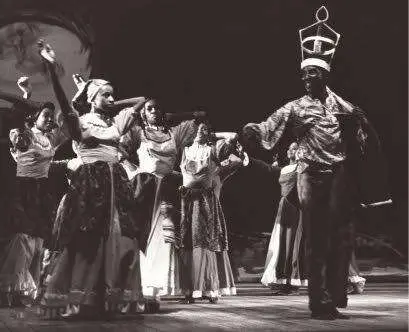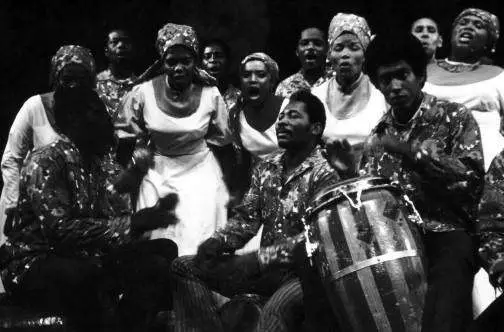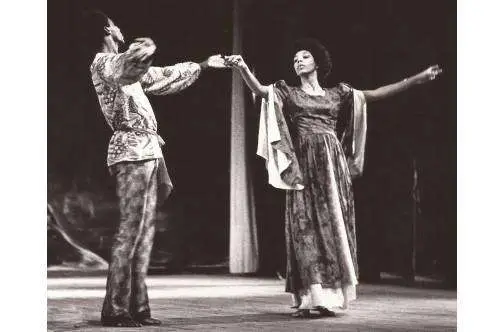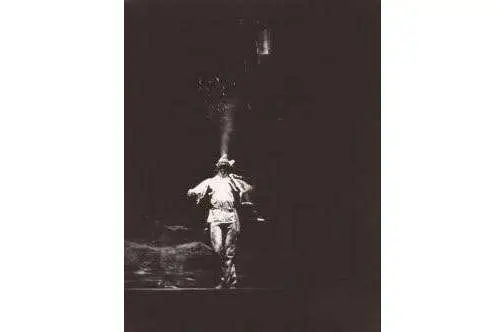
Kumina turns 50
Based on the Jamaican Afro-cult to be found largely in the parish of St Thomas. The rites are held fo a variety of occasions — for mourning, tombing, healing, thanksgiving and even when help is needed to win a court case or for winning a lover. Included is a dance combat called warrick (stick play) — National Dance Theatre Company of Jamaica (NDTC)
The image of the late Professor Rex Nettleford in crown and cape as the king in Kumina are forever burnished in the collective memories of thousands who enjoyed the performances over the years. The curtains open with the king inching across the stage to the infectious rhythm of the drummers, then in a tribute to the ancestor he offers libations and sprays of authentic Jamaican white rum are released for those who went before. As the NDTC singers raise their voices with the now-popular refrain, ‘I want to know, I want to know, let Kumina begin’.
Choreographed by Nettleford 50 years ago, the work has become one of the company’s signature pieces closing many a performances since it was first created for the 1971 season.
Founding member of the NDTC Bridget Spaulding (nee Casserly) was part of the cast once when the work was first set by Nettleford, and she shared with the Jamaica Observer the feeling at being part of the birth of something that has become part and parcel of the company’s dance lexicon.
“What Rex [Nettleford] wanted to do was really share a rich piece of Jamaican art and culture with a wider audience by transposing what is essentially a religious rite into performance. Even though he was doing it for performance, these had to be elements of authenticity in what he was reproducing. So the company was taken on one of the famous field trips to go to source and get that feel of what was being done, the essence of what was being taken to the performance level,” she noted.
Such was Nettleford’s commitment to authenticity that three traditional drummers from St Thomas — James walker, Samuel Copeland, and Obadiah Lewis — were co-opted into the company to provide accompaniment to the performances for many years. Spaulding noted that even the acquisition of new Kumina drums were subjected to the strict rules governing this religious rite.
“The logs used for the drums had to be harvested during a full moon… everything about the drums was a ritual and these were strictly observed. I recall that James could only play Kumina rhythms, so if we wanted anything else we had to find it elsewhere, as that was his specialisation,” said Spaulding.
She admitted that traditional folk forms were never her strong point. She had come to the NDTC with a strong background in classical ballet, however, Nettleford was adamant that all dancers in the company he co-founded with Eddy Thomas in 1962 should be exposed to a wide range of dance styles and genres so she had no choice but to be drawn in by the rhythm and movement patters of Kumina.
Spaulding recalled that the response to the very first performance of Kumina offered every indication to Nettleford and the NDTC that they had a special work on their hands.
“That first season we opened with Kumina and quickly realised that we had made a mistake and something we would never do again. The audience was so taken by the work, dancing and singing along and as a result all the other works that followed that evening fell flat. Since then it has always been the piece to close the show, leaving audiences on a high as they leave the theatre,” said Spaulding.
For that first performance of Kumina the NDTC cast comprised Nettleford, Spaulding, Pansy Hassan (who played the role of the queen), Noelle Chutkan, Joyce Campbell, Barbara Requa, Dorothy Sanguinetti, Fredericka Byfield, Bunny Heron, Dorothy Fraser, Shirley Campbell, Mavis Stoppi, Jean Binns, Monica McGowan, Barry Moncrieffe, Audley Butler, Tommy Pinnock, Jackie Guy, Noel Hall, Junior McGlashan, Tony Wilson, and Fitzroy Hunt.
Set and costumes for Kumina were designed by Don Bucknor.
Spaulding noted that although she has performed in and seen Kumina hundreds of times, there is always a special pull to the work which is celebrating its golden anniversary and remains a part of the company’s active repertoire and an audience favourite.
“There is something about the processional showcase that is present in Kumina — Rex was good at that. That is what gets the audience each time add to that the rhythm and the movement and the response from the audience is always great,” she noted.































